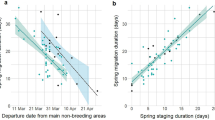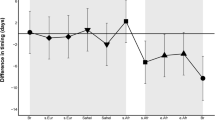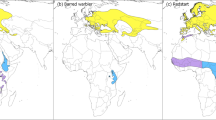Abstract
In migratory birds, mistimed arrival might have negative consequences for individual fitness, causing population declines. This may happen if arrival time is not synchronized with breeding time, especially when earlier springs favour earlier reproduction. We studied spring arrival time to the breeding areas in a pied flycatcher Ficedula hypoleuca population in southern Norway during a 30-year period (1985–2014). We investigated trends in arrival both for the entire population and for different population fractions (e.g. early vs. late arrivals). We also studied sex and age class differences, along with repeatability of arrival. Finally, we explored how arrival is influenced by environmental conditions at the areas birds use throughout the year, using mixed-effects models and quantile regressions with individual-based data. Spring arrival advanced over five days, at a similar rate through the entire population. Males and adult birds arrived earlier than females and yearlings. Arrival was significantly repeatable for males and females. Birds arrived earlier in years with high temperature and rainfall at the breeding grounds, and low NDVI both on the Iberian Peninsula and in central Europe. Later fractions of the population showed a steeper response to these environmental variables. This intra-population heterogeneity in the responses to the environment probably stems from a combination between the different selection pressures individuals are subject to and their age-related experience. Our results highlight the importance of studying how migration phenology is affected by the environment not only on the breeding grounds but also on the other areas birds use throughout the year.




Similar content being viewed by others
References
Ahola M, Laaksonen T, Sippola K, Eeva T, Rainio K, Lehikoinen E (2004) Variation in climate warming along the migration route uncouples arrival and breeding dates. Glob Change Biol 10:1610–1617
Alerstam T, Lindström Å (1990) Optimal bird migration: the relative importance of time, energy and safety. In: Gwinner E (ed) Bird migration: the physiology and ecophysiology. Springer, Berlin, pp 331–351
Balbontín J, Møller AP, Hermosell IG, Marzal A, Reviriego M, de Lope F (2009) Individual responses in spring arrival date to ecological conditions during winter and migration in a migratory bird. J Anim Ecol 78:981–989
Bartoń K (2015) MuMIn: Multi-Model Inference. R package version 1.15.1. http://CRAN.R-project.org/package=MuMIn
Bates D, Maechler M, Bolker B, Walker S (2013) lme4: Linear mixed-effects models using Eigen and S4. R package version 1.0-5. http://CRAN.R-project.org/package=lme4
Bauböck L, Miller-Rushing AJ, Primack RB, Lloyd Evans TL, Wasserman FE (2012) Climate change does not affect protandry in seven passerines in North America. Wilson J Ornithol 124:208–216
Both C (2010) Flexibility of timing of avian migration to climate change masked by environmental constraints en route. Curr Biol 20:243–248
Both C, Visser ME (2001) Adjustment to climate change is constrained by arrival date in a long-distance migratory bird. Nature 411:296–298
Both C, Artemyev AV, Blaauw B, Cowie RJ, Dekhuijzen AJ, Eeva T et al (2004) Large-scale geographical variation confirms that climate change causes birds to lay earlier. Proc R Soc Lond B 271:1657–1662
Both C, Bouwhuis S, Lessells CM, Visser ME (2006a) Climate change and population declines in a long-distance migratory bird. Nature 441:81–83
Both C, Sanz JJ, Artemyev AA, Blaauw B, Cowie RJ, Dekhuijzen AJ et al (2006b) Pied flycatchers Ficedula hypoleuca travelling from Africa to breed in Europe: differential effects of winter and migration conditions on breeding date. Ardea 94:511–525
Both C, Bijlsma RG, Ouwehand J (2016) Repeatability in spring arrival dates in pied flycatchers varies among years and sexes. Ardea 104:3–21
Both C, Burger C, Ouwehand J, Samplonius JM, Ubels R, Bijlsma RG (2017) Delayed age at first breeding and experimental removals show large non- breeding surplus in pied flycatchers. Ardea 105:43–60
Briedis M, Hahn S, Adamík P (2017) Cold spell en route delays spring arrival and decreases apparent survival in a long-distance migratory songbird. BMC Ecol 17:11
Burnham KP, Anderson DR (2002) Model selection and multimodel inference: a practical information-theoretic approach, 2nd edn. Springer, New York
Cade BS, Noon BR (2003) A gentle introduction to quantile regression for ecologists. Front Ecol Environ 1:412–420
Canal D, Jovani R, Potti J (2012) Male decisions or female accessibility? Spatiotemporal patterns of extra pair paternity in a songbird. Behav Ecol 23:1146–1153
Chan K-S, Ripley B (2012) TSA: time series analysis. R package version 1.01. http://CRAN.R-project.org/package=TSA
Conklin JR, Battley PF, Potter MA (2013) Absolute consistency: individual versus population variation in annual-cycle schedules of a long-distance migrant bird. PLoS ONE 8:e54535
Dale S, Rinden H, Slagsvold T (1992) Competition for a mate restricts mate search of female pied flycatchers. Behav Ecol Sociobiol 30:165–176
de la Hera I, Pulido F, Visser M (2014) Longitudinal data reveal ontogenetic changes in the wing morphology of a long-distance migratory bird. Ibis 156:209–214
Dunn PO, Winkler DW (2010) Effects of climate change on timing of breeding and reproductive success in birds. In: Møller AP, Fiedler WP, Berthold P (eds) Effects of climate change on birds. Oxford University Press, London, pp 113–128
Fox J, Weisberg S (2011) An {R} companion to applied regression. 2nd Edition. Thousand Oaks CA: Sage. http://socserv.socsci.mcmaster.ca/jfox/Books/Companion
Gienapp P, Bregnballe T (2012) Fitness consequences of timing of migration and breeding in cormorants. PLoS ONE 7:e46165
Gordo O (2007) Why are bird migration dates shifting? A review of weather and climate effects on avian migratory phenology. Clim Res 35:37–58
Gordo O, Doi H (2012) Drivers of population variability in phenological responses to climate change in Japanese birds. Clim Res 54:95–112
Gordo O, Sanz JJ (2008) The relative importance of conditions in wintering and passage areas on spring arrival dates: the case of long-distance Iberian migrants. J Ornithol 149:199–210
Gordo O, Sanz JJ (2010) Impact of climate change on plant phenology in Mediterranean ecosystems. Glob Change Biol 16:1082–1106
Gordo O, Tryjanowski P, Kosicki JZ, Fulín M (2013) Complex phenological changes and their consequences in the breeding success of a migratory bird, the white stork Ciconia ciconia. J Anim Ecol 82:1072–1086
Gwinner E, Helm B (2003) Circannual and circadian contributions to the timing of avian migration. In: Berthold P, Gwinner E, Sonnenschein E (eds) avian migration. Springer, Heidelberg, pp 81–95
Harnos A, Nóra Á, Kovács S, Lang Z, Csörgő T (2015) Increasing protandry in the spring migration of the pied flycatcher (Ficedula hypoleuca) in Central Europe. J Ornithol 156:543–546
Hüppop O, Hüppop K (2003) North Atlantic oscillation and timing of spring migration in birds. Proc R Soc Lond B 270:233–240
Hüppop O, Winkel W (2006) Climate change and timing of spring migration in the long-distance migrant Ficedula hypoleuca in central Europe: the role of spatially different temperature changes along migration routes. J Ornithol 147:344–353
Hurrell JW (1995) Decadal trends in the North Atlantic oscillation: regional temperatures and precipitation. Science 269:676–679
IPCC (2013) Climate Change 2013: the physical science basis. In: Stocker TF, Qin D, Plattner G-K, Tignor M, Allen SK, Boschung J, Nauels A, Xia Y, Bex V, Midgley PM (eds) Contribution of Working Group I to the Fifth Assessment Report of the Intergovernmental Panel on Climate Change. Cambridge University Press, Cambridge
Johnson PCD (2014) Extension of Nakagawa & Schielzeth’s R2 GLMM to random slopes models. Meth Ecol Evol 6:133–142
Jonzén N, Lindén A, Ergon T, Knudsen E, Vik JO, Rubolini D et al (2006) Rapid advance of spring arrival dates in long-distance migratory birds. Science 312:1959–1961
Kanamitsu M, Ebisuzaki W, Woollen J, Yang S-K, Hnilo JJ, Fiorino M, Potter GL (2002) NCEP-DOE AMIP-II reanalysis (R-2). Bull Am Meteor Soc 83:1631–1643
Knudsen E, Lindén A, Ergon T, Jonzén N, Vik JO, Knape J et al (2007) Characterizing bird migration phenology using data from standardized monitoring at bird observatories. Clim Res 35:59–77
Knudsen E, Lindén A, Both C, Jonzén N, Pulido F, Saino N et al (2011) Challenging claims in the study of migratory birds and climate change. Biol Rev 86:928–946
Koenker R (2015) Quantreg: Quantile Regression. R package version 5.19. http://CRAN.R-project.org/package=quantreg
Lundberg A, Alatalo RV (1992) The pied flycatcher. T & AD Poyser, London
Martínez-de la Puente J, Merino S, Lobato E, Moreno J, Tomás G, Morales J (2009) Male nest-building activity influences clutch mass in pied flycatchers Ficedula hypoleuca. Bird Study 56:264–267
Menzel A, Sparks TH, Estrella N, Koch E, Aasa A, Ahas R et al (2006) European phenological response to climate change matches the warming pattern. Glob Change Biol 12:1969–1976
Møller AP, Merilä J (2004) Analysis and interpretation of long-term studies investigating responses to climate change. Adv Ecol Res 35:111–130
Møller AP, Rubolini D, Lehikoinen E (2008) Populations of migratory bird species that did not show a phenological response to climate change are declining. Proc Natl Acad Sci USA 105:16195–16200
Nakagawa S, Schielzeth H (2010) Repeatability for Gaussian and non-Gaussian data: a practical guide for biologists. Biol Rev 85:935–956
Nakagawa S, Schielzeth H (2013) A general and simple method for obtaining R 2 from Generalized Linear Mixed-effects Models. Meth Ecol Evol 4:133–142
Newton I (2007) Weather-related mass-mortality events in migrants. Ibis 149:453–467
Newton I (2008) The migration ecology of birds. Academic Press, London
Ouwehand J, Both C (2016) Alternate non-stop migration strategies of pied flycatchers to cross the Sahara desert. Biol Lett 12:20151060
Ouwehand J, Both C (2017) African departure rather than migration speed determines variation in spring arrival in pied flycatchers. J Anim Ecol 86:88–97
Ouwehand J, Ahola MP, Ausems ANMA et al (2016) Light-level geolocators reveal migratory connectivity in European populations of pied flycatchers Ficedula hypoleuca. J Avian Biol 47:69–83
Pettorelli N, Vik JO, Mysterud A, Gaillard J-M, Tucker CJ, Stenseth NC (2005) Using the satellite-derived NDVI to assess ecological responses to environmental change. Trends Ecol Evol 20:503–510
Potti J (1998) Arrival time from spring migration in male pied flycatchers: individual consistency and familial resemblance. Condor 100:702–708
R Core Team (2015) R: a language and environment for statistical computing. R Foundation for Statistical Computing, Vienna. https://www.R-project.org/
Rainio K, Tøttrup AP, Lehikoinen E, Coppack T (2007) Effects of climate change on the degree of protandry in migratory songbirds. Clim Res 35:107–114
Robson D, Barriocanal C (2011) Ecological conditions in wintering and passage areas as determinants of timing of spring migration in trans-Saharan migratory birds. J Anim Ecol 80:320–331
Saino N, Szép T, Romano M, Rubolini D, Spina F, Møller AP (2004) Ecological conditions during winter predict arrival date at the breeding quarters in a trans-Saharan migratory bird. Ecol Lett 7:21–25
Saino N, Ambrosini R, Rubolini D, von Hardenberg J, Provenzale A, Hüppop K et al (2011) Climate warming, ecological mismatch at arrival and population decline in migratory birds. Proc R Soc B 278:835–842
Schaub M, Jenni L, Bairlein F (2008) Fuel stores, fuel accumulation, and the decision to depart from a migration stopover site. Behav Ecol 19:657–666
Sergio F, Tanferna A, De Stephanis R, López Jiménez L, Blas J, Tavecchia G et al (2014) Individual improvements and selective mortality shape lifelong migratory performance. Nature 515:410–413
Sparks T, Tryjanowski P, Cooke A, Crick H, Kuźniak S (2007) Vertebrate phenology at similar latitudes: temperature responses differ between Poland and the United Kingdom. Clim Res 34:93–98
Spottiswoode CN, Tøttrup AP, Coppack T (2006) Sexual selection predicts advancement of avian spring migration in response to climate change. Proc R Soc Lond B 273:3023–3029
Stenseth NC, Ottersen G, Hurrell JW et al (2003) Studying climate effects on ecology through the use of climate indices: the North Atlantic Oscillation, El Niño Southern Oscillation and beyond. Proc R Soc Lond B 270:2087–2096
Studds CE, Marra PP (2011) Rainfall-induced changes in food availability modify the spring departure programme of a migratory bird. Proc R Soc Lond B 278:3437–3443
Svensson L (1992) Identification Guide to European Passerines. Fingraf AB, Södertälje
Tarka M, Hansson B, Hasselquist D (2015) Selection and evolutionary potential of spring arrival phenology in males and females of a migratory songbird. J Evol Biol 28:1024–1038
Taylor B, Christie DA (2015) European pied flycatcher (Ficedula hypoleuca). In: del Hoyo J, Elliott A, Sargatal J, Christie DA, de Juana E (eds) Handbook of the birds of the world alive. Lynx Edicions, Barcelona, pp 128–129
Tøttrup AP, Thorup K (2008) Sex-differentiated migration patterns, protandry and phenology in North European songbird populations. J Ornithol 149:161–167
Tøttrup AP, Thorup K, Rainio K, Yosef R, Lehikoinen E, Rahbek C (2008) Avian migrants adjust migration in response to environmental conditions en route. Biol Lett 4:685–688
Acknowledgements
The authors are indebted to Anders Herland and the many master and PhD students that helped collecting the data, and to Arthur Bass for collaborating in digitizing and organizing the information. L.C. was funded by EU’s PEOPLE Programme (Marie Curie Actions), grant agreement number 255326. Yngvild Vindenes, Andreas Lindén and Andrew Beckerman helped with statistical analyses. Jan Ohlberger, Morten Helberg and Øystein Langangen provided fruitful discussions. Christiaan Both, Blair Wolf and an anonymous reviewer significantly helped improve the manuscript.
Author information
Authors and Affiliations
Contributions
LC, AL, AN, HML, TS and NCS conceived the idea. HML and TS conducted fieldwork. EK analysed part of the data. LC analysed the rest of data and did the statistical modelling. LC, AL, EK and AN wrote the manuscript. HML, TS and NCS provided editorial advice.
Corresponding author
Additional information
Communicated by Blair Wolf.
Electronic supplementary material
Below is the link to the electronic supplementary material.
Rights and permissions
About this article
Cite this article
Cadahía, L., Labra, A., Knudsen, E. et al. Advancement of spring arrival in a long-term study of a passerine bird: sex, age and environmental effects. Oecologia 184, 917–929 (2017). https://doi.org/10.1007/s00442-017-3922-4
Received:
Accepted:
Published:
Issue Date:
DOI: https://doi.org/10.1007/s00442-017-3922-4




